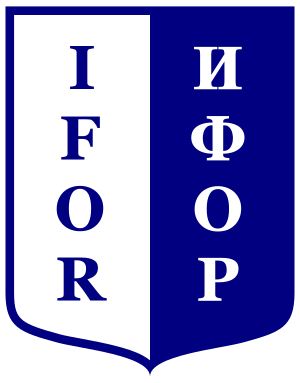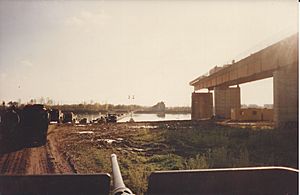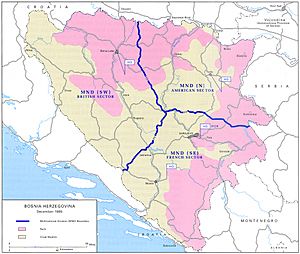Implementation Force facts for kids
Quick facts for kids Implementation Force |
|
|---|---|

Pocket badge of the IFOR
|
|
| Active | 1995–1996 |
| Country | 32 countries |
| Type | Command |
| Part of | |
| Nickname(s) | "IFOR" |
The Implementation Force (IFOR) was a special group of soldiers led by NATO. Their job was to help keep the peace in Bosnia and Herzegovina after a war. They worked for one year, from December 20, 1995, to December 20, 1996. Their mission was called Operation Joint Endeavour.
Why IFOR Was Needed
NATO was asked by the United Nations (UN) to make sure the Dayton Peace Accords were followed. This peace agreement was signed by the leaders of Bosnia, Croatia, and Serbia on December 14, 1995, in Paris.
The main goals of the peace agreement were:
- To stop all fighting.
- To start military and civilian programs to help the country.
- To create a new government in Bosnia.
IFOR's specific job was to carry out the military parts of this peace agreement.
IFOR took over from an earlier UN peacekeeping group called UNPROFOR, which had been there since 1992. About 60,000 NATO soldiers, plus troops from other countries not in NATO, were sent to Bosnia. IFOR started its work on December 20, 1995.
The Dayton Agreement was signed after many problems. Earlier peace plans had failed. There were also serious events like the Srebrenica massacre, where many people were killed. UN peacekeepers were even used as human shields during NATO's air attacks in 1995. These events showed that a stronger force was needed to bring peace.
Admiral Leighton W. Smith Jr. was the first commander of IFOR. He led the operation from December 1995. Later, Admiral Thomas J. Lopez and General William W. Crouch also commanded IFOR. This was the first time NATO sent a large ground force outside its usual area.
At its peak, IFOR had soldiers from 32 different countries. There were about 54,000 soldiers in Bosnia itself. Many more support troops were in nearby countries like Croatia and Hungary. In the beginning, many IFOR soldiers were already in Bosnia as part of UNPROFOR. They simply changed their UN badges for IFOR ones.
Who Was Part of IFOR
Many countries helped IFOR. Countries that are part of NATO included Belgium, Canada, Denmark, France, Germany, Italy, Luxembourg, the Netherlands, Norway, Portugal, Spain, Turkey, the United States, and the United Kingdom.
Countries not in NATO that also helped were Australia, Austria, Bangladesh, the Czech Republic, Egypt, Estonia, Finland, Hungary, Latvia, Lithuania, Malaysia, New Zealand, Pakistan, Poland, Romania, Slovakia, Sweden, Russia, and Ukraine.
IFOR's ground forces were divided into three main Multi-National Divisions:
- Multi-National Division (South-East) in Mostar: This division was led by France. It included French, Spanish, Italian, and Portuguese soldiers. It also had units from Egypt, Jordan, Ukraine, and Morocco.
- Multi-National Division (South-West) in Banja Luka: This division was led by the United Kingdom. It included British, Canadian, and Dutch soldiers. The British part of this mission was called Operation Resolute.
- Multi-National Division (North) in Tuzla: This division was led by the United States. The U.S. Army's 1st Armored Division formed most of this group. It also included a Russian brigade, a Turkish brigade, and the Nordic-Polish Brigade.
- A Russian brigade was part of this effort.
- The Nordic-Polish Brigade was a group of soldiers from Denmark, Estonia, Finland, Latvia, Lithuania, Norway, Poland, Sweden, and the USA. It was formed in 1996 and stayed in Bosnia until 2000.
After IFOR finished its mission on December 20, 1996, another force called SFOR took over. Later, in 2004, the European EUFOR Althea force replaced SFOR.
NATO also created special medals for soldiers who served in peacekeeping missions like IFOR. This medal is called the NATO Medal.
Gallery
-
Two Russian BTR-80 armored vehicles following an American Humvee in Zvornik.
-
Greek soldiers guarding a truck with voting equipment for the 1996 Bosnian general election in Zenica.
See also
 In Spanish: IFOR para niños
In Spanish: IFOR para niños
- National Support Group










